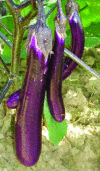Restoring pollen fertility in transgenic male-sterile eggplant by Cre/loxp-mediated site-specific recombination system
- PMID: 21637486
- PMCID: PMC3036876
- DOI: 10.1590/S1415-47572010005000043
Restoring pollen fertility in transgenic male-sterile eggplant by Cre/loxp-mediated site-specific recombination system
Abstract
This study was designed to control plant fertility by cell lethal gene Barnase expressing at specific developmental stage and in specific tissue of male organ under the control of Cre/loxP system, for heterosis breeding, producing hybrid seed of eggplant. The Barnase-coding region was flanked by loxP recognition sites for Cre-recombinase. The eggplant inbred/pure line ('E-38') was transformed with Cre gene and the inbred/pure line ('E-8') was transformed with the Barnase gene situated between loxp. The experiments were done separately, by means of Agrobacterium co-culture. Four T(0) -plants with the Barnase gene were obtained, all proved to be male-sterile and incapable of producing viable pollen. Flowers stamens were shorter, but the vegetative phenotype was similar to wild-type. Five T (0) -plants with the Cre gene developed well, blossomed out and set fruit normally. The crossing of male-sterile Barnase-plants with Cre expression transgenic eggplants resulted in site-specific excision with the male-sterile plants producing normal fruits. With the Barnase was excised, pollen fertility was fully restored in the hybrids. The phenotype of these restored plants was the same as that of the wild-type. Thus, the Barnase and Cre genes were capable of stable inheritance and expression in progenies of transgenic plants.
Keywords: Barnase gene; Cre gene; Cre/loxP system; eggplant; male sterility.
Figures











References
-
- Bayer M., Hess D. Restoring full pollen fertility in transgenic male-sterile tobacco (Nicotiana tabacum L. ) by Cre-mediated site-specific recombination. Mol Breed. 2005;15:193–203.
-
- Bayley C.C., Morgan M., Dale E.C., Ow D.W. Exchange of gene activity in transgenic plants catalyzed by the Cre-lox site-specific recombination system. Plant Mol Biol. 1992;18:353–361. - PubMed
-
- Bisht N.C., Jagannath A., Gupta V., Burma P.K., Pental D. A two gene-two promoter system for enhanced expression of a restorer gene (barstar) and development of improved fertility restorer lines for hybrid seed production in crop plants. Mol Breed. 2004;14:129–144.
-
- Bisht N.C., Jagannath A., Burma P.K., Pradhan A.K., Pental D. Retransformation of a male sterile barnase line with the barstar gene as an efficient alternative method to identify male sterile-restorer combinations for heterosis breeding. Plant Cell Rep. 2007;26:727–733. - PubMed
-
- Burgess D.G., Ralston E.J., Hanson W.G., Heckert M., Ho M., Jenq T., Palys J.M., Tang K., Gutterson N. A novel, two-component system for cell lethality and its use in engineering nuclear male-sterility in plants. Plant J. 2002;31:113–125. - PubMed
LinkOut - more resources
Full Text Sources
Other Literature Sources
